| |
 |
The first revenue issue, of the 9th Army area management |
 |
|
 |
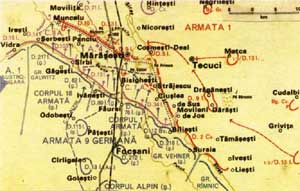
Photo 1
|
Historical considerations
At the end of 1916, the Central Powers armies occupy much of the national territory of Romania.
Compared to the rest of the occupied territory under the Military Administration of Romania (MViR), a territory that includes the area near the front, comprising the counties of Buzau, Ramnicu Sarat, Braila and Putna went into administration and the 9th Army.
City Focsani falls under German occupation from 25 December 1916, which would be released only on 10 November 1918. Here he established his Headquarters the 1st Corps of the Army 9.
1st Corps commander was General Kurt von Morgen, a general at the end of a career, crowned with many victories and military honors.
Focsani city had during the 1912 census, 25,066 population, being the administrative center of Putna County. In the nearly two years of German occupation, there are three different periods of administration.
In the first phase by March 1917, the city is heavily garrisoned troops using all public institutions, schools, hospitals and private houses.
.
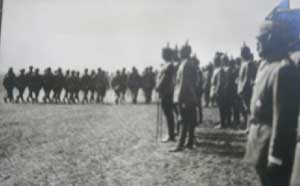
Photo 2
|
The second period, until June 1918, is a reorganization of the administration. All administrative acts issued, should be checked and endorsed by representatives of the occupying army. It was a massive period of requisition, shortages and arrests.
The third period, until November 1918, is one of intense bombing and fighting, the German army was in retreat.
Three important events occurred in 1917.
The first was the panic that came on German soldiers after the defeat at Marasesti, and enthusiasm of the Romanian population, on the submission of the Romanian army in August 1917.
The second occurred on 22 September 1917, when the city of Focsani, given Kaiser's Wilhelm II visit, who came to inspect the troops and raise morale of the soldiers after Mărăşeşti failures. Kaiser takes this occasion a speech in which he said King Ferdinand of Romania, a traitor.
The third event that would bring the population, much suffering, was a signing of the armistice between representatives of the Armies of Germany, Austria-Hungary, Bulgaria and the Ottoman Empire, and representatives of the Romanian Army, on 9 December 1917, in the house Apostoleanu from the same city.
In the City Hall and has established the German military headquarters, which is where used most revenue stamps, during the German occupation. It is possible, especially in high value stamps, were used and the Court Focsani, but there is no concrete evidence to that effect.
Legislative framework
In terms of tax legislation, compared to the post, things have moved more quickly because there was no problem securing a flow of information specific to areas of conflict, even contrary, to create a framework for the collection of amounts needed at that conjuncture.
So since January 1917 are regulated by the Military Administration of Romania, the new legislation, taking Romanian laws of February 4, 1906 and December 24, 1914 with related articles, but changing taxes.
Table with fiscal taxes from the territories occupied by the German Army, January 1917
In the territory under the German Administration it is ordered that taxes that are to be paid with revenue stamps to be paid according to the Romanian laws from the 4th of February 1906 and 24th of December 1914. The failure to use these stamps for these taxes shall be punished, as well as the forgery or reuse and the unauthorized trade in this material. The sale of revenue stamps shall be made as until now by retail salesmen or other authorized persons who shall acquire them from the stamp warehouse. Valid shall be only stamps with the M.V.i.R overprint (Military Administration in Romania). An important novelty is that the Charity Stamps are distributed so far through post offices, can be bought here before the retailers or the financial agency.
A) The value of 10 Bani shall be used:
1) for accounting registers of tradesmen, manufacturers, hotels, pharmacists,
intermediaries, etc;
2) for cheques, payment orders and receipts;
3) for receiving confirmations of any kind;
4) for accounting acts, memorandums, invoices, etc, when the value of the object
does not exceed 200 lei;
5) for letter notices and frahts (carriage letters);
6) for citations and reclamations;
7) for papers which authorize the sale of cattle.
B) The 30 Bani value shall be used for:
a) for all requests and demands forwarded to authorities;
b) for legalizing, confirmations, authentication of various acts, diplomas, documents,titles forwarded to the authorities;
c) for payment receipts in bank operations and transactions;
d) for passports and identification acts;
e) for accounting acts, memorandums, invoices, etc, when the value of the object exceeds 200 lei.
Article 23 of the law from the 23 of December 1914 requested that besides these taxes an extra stamp of 10 Bani, and for bank memorandums one of 20 bani.
The mentioned sums are increased through the new dispositions to the 20 and 40 Bani, so that for points 1-7 the tax is of 30 Bani and for those from a - e is of 50 Bani; regarding bank memorandums the tax is of 50 or 70 Bani, according to the value of the object. In the case in which the postal activity shall be resumed, besides the postage stamp a 10 Bani revenue stamp has to be added; telegrams (within the territory under the German Military Administration) shall have added a 20 Bani revenue stamps. New is also the disposition regarding the requests addressed to the occupation force authorities. If these requests are not tax exempted a 1 Leu revenue stamp tax shall be applied.
Article 43 refers to tax exemptions. Besides those mentioned there, the followings are also tax exempted.
- acts submitted at the authorities requests;
- requests for granting help;
- acts and documents of banks which perform financial operations with the occupation forces.
Information regarding fiscal taxes can be found in the province at the Financial Administration.
The Military Administration in Romania
Revenue stamps that were overprinted were exclusively Romanian, fills in the first phase from the remaining stocks of issuing stamps in 1911 Charles I, but then after these stocks have been exhausted and because this show clichés remained in Bucharest after withdrawal of the Romanian administration, other stamps were issued using the same clichés but the paper or color changed both to revenue issue stamps Charles I and the help stamps of 1916.
Local revenue stamps with overprint "Steuermarke / Gultig fur / 1. Res - Korps / 10 Bani
( 30 Bani, 1 Leu, 5 Lei)"
As a precursor to the issuance of revenue stamps overprinted with "Gultig 9. Armee"appears in Focsani, which was based 1st army corps command under Army 9, an issue of stamps with overprint Steuermarke / Gultig fur / 1. Res - Korps / 10 Bani ( 30 Bani, 1 Leu, 5 Lei), listed in the Romanian revenues Catalogue by the Mihai Cojocar (2006) to different issues page 221, without giving a lot of data about it. And there are so few errors, the 30 B is green not black as it goes in the catalog, and design are two women wearing each a flag, not a woman and a soldier as it passed in the catalog.
 |
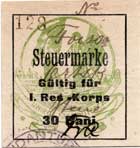 |
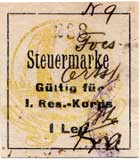 |
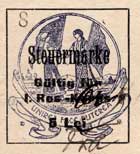 |
|
Photo 3
|
Photo 4
|
Photo 5
|
Photo 6
|
|
These mistakes are corrected in the 2011 catalog of the same author, on page 249, appeared another mistake like that "some experts consider as prefiguration of the union that will occur in 1918". In the revenue stamps catalog by Barefoot & Valentin Robu, this issue is, rightly, to broadcasts during the German occupation and also mentions the union of the two principalities allegory. Unfortunately, some mistakes occur here, namely, state 1918, which is wrong because they appeared and were in use only in 1917, and in the number, color and values appear misinformation stamps. Values appear in the catalog 10 B - Red 30 B - yellow (instead of green) and 40 b - purple - falsely, this value was not met and had no reason to be given the tariffs under the law. No one mentioned values 1 L and 5 L.
The stamp design are two women in traditional costumes giving his hand, representing the union of the two Romanian provinces, Moldavia and Wallachia. The flags held by the two women are represented Moldova aurochs and Wallachia Eagle. The background shows two sides of the river Milcov, the Moldavian and Wallachian. Under the drawing is a slogan "unity is strength". This drawing is from local stamps issued in 1914 on the Focsani village emblem represent Focsani city called "town of Union". So this drawing was a tribute to the union in 1859.
Stamps design characteristics
Cliché size is 42 / 42.5 mm.
Printing of all values was performed using the same cliche same micro signs appeared at all levels, the difference is only given by color. So using a single cliche, as the famous Bull Head. Here is another inconsistency with information in published revenues catalogs, which stated that they were made by lithography. Characteristic of micro signs are:
. Line located about 1.5 mm outer circle of the dial at 13 hourly;
. Thinned outer circle were broken at 13 o'clock;
. Outer circles connected by color dots, between hours 10 and 11 of the clock;
. Bold lines and circles joined at 11 o'clock.
The same cliche, having the same dimensions and keeping some of the above features are found in a document header Focsani Urban Village Hall on 8 July 1926, nine years later, evidence that this cliché was not destroyed, at least not then.
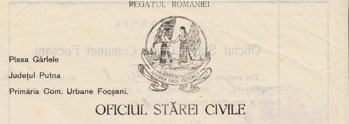
Photo 7
|
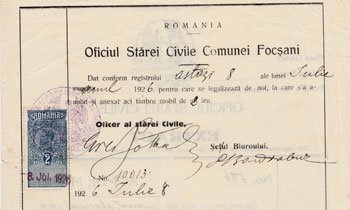
Photo 8
|
The existence of this document leads to the conclusion that this cliché, there is the printing of Focsani being made for a different purpose, ie to print the forms header Hall, in any case to print the stickers or stamps. Just made this cliché conjuncture be used for this purpose, transformation is made by revenue stamps overprint.
The similarities of the two designs underlying allegation that he used the same cliché are:
. Identical dimensions;
. Thin outer circle were broken at 13 hour of the clock;
. Outer circles connected by dots of color between 10 and 11 on the clock;
. Bold lines and circles joined at 11 o'clock;
Although it is obvious similarity of the two designs, even if there are a few differences resulting from a correcting the cliche, such as :
. The disappearance of the line, about 1.5 mm located at the outer circle of the 13 hour for the clock, the cliché used in 1926;
. The disappearance of the two circles, located under the scarf, with the sloganon the left and right.
History and evolution of the design basis
The first occurrence of this issue illustrates the union of the two principalities, a find pattern flag municipal guard in 1867, after the 1867 law (Law for fixing and establishing weapons Romania in meeting Assembly members voted March 26, 1867, Official Gazette no. 75/1867)
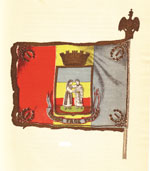 |
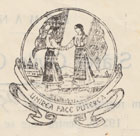 |
 |
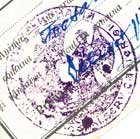 |
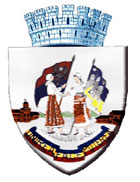 |
|
Photo 9
|
Photo 10
|
Photo 11
|
Photo 12
|
Photo 13
|
|
Stamps colours
It is worth mentioning that three of the four stamps are the national colors, which makes us think the United Principalities issues and the first lithographed stamps issues.
Thus the message design, colors used, had a strong national brands as a defiance against the occupying authorities, probably generated the enthusiasm that swept the entire population of the city after the victory of the Romanian army from Marasesti, 6 to 19 August 1917.
As I have said, the differences between the marks are given only the colors have been printed. We met the following colors and several color varieties such as:
. On 10 B - Red-violet shades;
. On 30 B - Green-yellow to stamps with small series up to number 128 and pale yellow-green, to the stamps with larger series;
At a 1 Leu - to the stamps pale yellow with small series up to number 238, and to series with higher numbers, intense yellow;
. On 5 Lei - indigo blue.
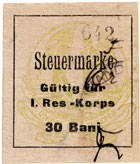 |
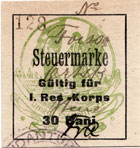 |
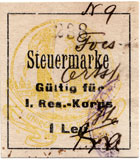 |
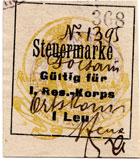 |
|
Photo 14
|
Photo 15
|
Photo 16
|
Photo 17
|
|
Overprint.
Black overprint, includes framework stamp, which has dimensions 41.5 to 42 mm / 46 to 46.5 mm, showing displacement or rotation of the frame to the drawing..
Characteristic cracks appear in the frame, resulting in two types of overprint.
Overprint types
Type 1, are characteristic:
. Point over the letter "t" in Steuermarke;
. The second "e" in Steuermarke lower loop interrupted;
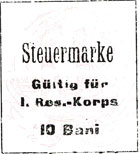
Photo 18
|
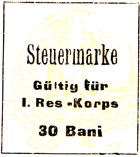
Photo 19 |
The second "r" in Steuermarke with foot pinched;
. The letter "l" in Gültig pointed to the top;
. Cracks framework as shown in Photo 18.
This type is found to all 10 B stamps, and some of the 1 L
In Type 2 characteristics are:
. Leak in the top of the first loop of the letter "m" in Steuermarke;
. The letter "a" from Steuermarke broken ;
. Cracks framework as shown in photo 19;
. No comma after "Res".
This type is common to all the stamps of 30 B and 5 L.
Stamps paper
The paper is thick with yellowish tint. At the stamps with values of 10 B and 30 B can be observed two types of paper. For serial numbers between 600 and 700 was used yellow paper.
Cutting stamp was made with scissors, the dimensions are quite varied, between 52.5 - 57 mm in the vertical dimension and 46.5 - 51.5 mm in size horizontally. It is worth mentioning that the stamps with consecutive series, the vertical size is the same, hence we conclude that run horizontally cut first.
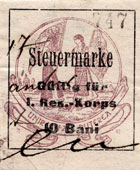 |
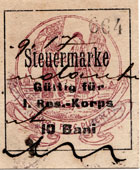 |
 |
|
Photo 20
|
Photo 21
|
Photo 22
|
|
A problem for future studies is the timing of the cutting was performed. Lack of pairs, even stamps with consecutive series, leads to the conclusion that cutting does not execute when used, being cut before.
Application of serial numbers in gray, is performed by stamping and we identified the following position:
. At the the 10 B serial number is in the top right;
. To the value of 30 B in the top right or left corner;
. At the 1 Leu above the right, left or middle;
. At 5 Lei in the top left.
A special case is a 10-stamp money with consecutive double overprint, 669, 670 (photo 22).
Establishing the first day and last day of use of the stamps
This issue had four levels, 10 B, 30 B, 1 L and 5 L, the exact values which they had and the other issues of overprinted revenue stamps, used for tax purposes in the occupied territory.
Another feature of these stamps, which help to us, is that each stamp has the very useful serial number to determine consumption, appearance date and the last uses.
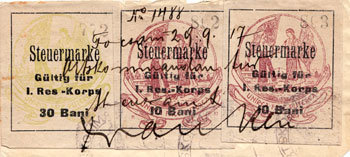
Photo 23
|
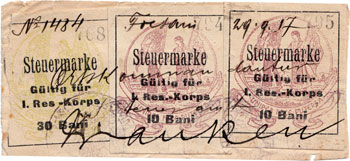
Photo 24
|
On the basis of a few stamps, a document, and three fragments of the paper, I will try to find some answers on this issue.
Fragments of documents used in 29. 09. 1917, 50 B properly charged under the law. (photo 23-24).
Request to the administration, the correct rate of 50 B under the law of January 1917.
The document presented used on 21. in September. 1917, has two stamps of 10 B, serial numbers 489, 490, and a stamp of 30 B with number 495 (photo 25).
May knew two 10 B stamps on fragment, which are marked with the date 29. in September. 1917 and which have numbers 786,787 (photo 26).
As with the rest of the occupied territory, and the administration area of the 9th Army, the question remains, how fees are charged between January 1917 when the legislation was already created, and June-July 1917.
All that is possible that these fees have been paid in cash, by issuing receipts, but this process is cumbersome, requiring additional officers to fill those receipts.
It is obvious that there was need for issuing of revenue stamps.
We determined statistically, based on documents from Focsani Hall, an average traffic of 48 requests per day by the administration, franked with stamps, Steuermerke, as will be seen below, during September-October 1917..
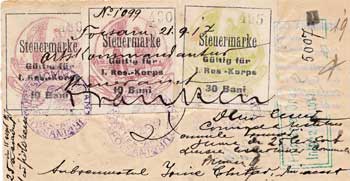
Photo 25
|
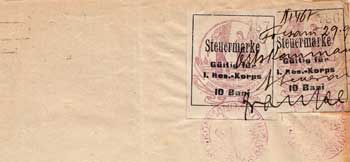
Photo 26
|
The following table describes the information available, ie, in column 1, the date from September 3, 1917 until October 10, 1917.
In columns 2 and 3, the theoretical numbers of documents while maintaining a rate of 48 documents per day.
In column 4, verify whether the this rate using information from the stamps and documents.
In columns 5,6,7 and 8 serial numbers of stamps in various values, and in column 9, the number of days that were in use.
Calculating the rate of consumption of the same table, we can deduce the first day for release in use, namely,September 3, 1917.
Stamp of 30 B, Series No. 54, dated 4. 09. 1917 is the earliest use of these stamps in the second day of their use.
Regarding the last day of use it may be on or around October 10, 1917, when they were replaced with Carol I revenue stamps "Gultig 9. Armee" overprinted, thick frame.
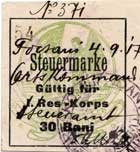
Photo 27
|
| Date |
From |
To |
No.
Document |
10 b. |
30 b. |
1 L. |
5 L. |
No. days
|
| 3 |
300 |
348 |
|
|
|
|
|
1 |
| 4 |
349 |
397 |
371 |
|
54 |
|
|
2 |
| 5 |
398 |
446 |
411 |
|
|
38 |
|
3 |
| 6 |
447 |
495 |
|
|
|
|
|
4 |
| 7 |
496 |
544 |
|
|
|
|
|
5 |
| 8 |
545 |
593 |
|
|
|
|
|
6 |
| 9 |
|
|
|
|
|
|
|
7 |
| 10 |
594 |
642 |
|
|
|
|
|
8 |
| 11 |
643 |
691 |
|
|
|
|
|
9 |
| 12 |
692 |
740 |
|
|
|
|
|
10 |
| 13 |
741 |
789 |
|
|
|
|
|
11 |
| 14 |
790 |
838 |
|
|
|
|
|
12 |
| 15 |
839 |
887 |
|
|
|
|
|
13 |
| 16 |
|
|
|
|
|
|
|
14 |
| 17 |
888 |
936 |
|
|
|
|
|
15 |
| 18 |
937 |
985 |
9... |
|
|
238 |
|
16 |
| 19 |
986 |
1034 |
|
|
|
|
|
17 |
| 20 |
1035 |
1083 |
|
|
|
|
|
18 |
| 21 |
1084 |
1132 |
1099 |
490 |
495 |
|
|
19 |
| 22 |
1133 |
1181 |
|
|
|
|
|
20 |
| 23 |
|
|
|
|
|
|
|
21 |
| 24 |
1182 |
1230 |
|
|
|
|
|
22 |
| 25 |
1231 |
1279 |
|
|
|
|
|
23 |
| 26 |
1280 |
1328 |
|
|
|
|
|
24 |
| 27 |
1329 |
1377 |
1312 |
|
652 |
|
|
25 |
| 28 |
1378 |
1426 |
1395 |
|
|
368 |
|
26 |
| 29 |
1427 |
1475 |
1433 |
744 |
|
|
|
27 |
| |
|
|
1467 |
787 |
|
|
|
|
| |
|
|
1484 |
795 |
768 |
|
|
|
| |
|
|
1488 |
803 |
772 |
|
|
|
| 30 |
|
|
|
|
|
|
|
28 |
| 1 |
1476 |
1524 |
|
|
|
|
|
29 |
| 2 |
1525 |
1573 |
|
|
|
|
|
30 |
| 3 |
1574 |
1622 |
|
|
|
|
|
31 |
| 4 |
1623 |
1671 |
|
|
|
|
|
32 |
| 5 |
1672 |
1720 |
|
|
|
|
|
33 |
| 6 |
1721 |
1769 |
|
|
|
|
|
34 |
| 7 |
|
|
|
|
|
|
|
35 |
| 8 |
1770 |
1818 |
|
|
|
|
|
36 |
| 9 |
1819 |
1867 |
|
|
|
|
|
37 |
| 10 |
1868 |
1916 |
|
|
|
|
126 |
38 |
| |
|
|
2094 |
1108 |
991 |
538 |
126 |
|
|
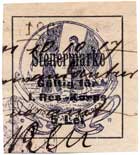
Photo 28 |
Stamp as proof presenting a 5-L, Steuermarke with handwritten date of 10. October 1917 and a pair of 1L revenue stamps Carol I with overprint "Gultig 9. Armee", by hand dated 11.10.1917 (photo 29).
There are no known documents with mixed franking, Steuermarke, and Carol Ioverprinted revenues or documents demonstrating their use in parallel for a while.
In conclusion, these stamps were in use only 33 days that were issued around 1,700 documentsof which the stamp of 10 B, 541 pcs, 30 B, 437 pieces, with 1 Leu, 528 pcs. and 5 Lei, 130 pcs.
Obliteration of the stamps
Under the provisions, all documents must be supervised by a representative of the occupying forces.
Cancellations (cancellation of) stamps were made by hand, with a particular rule, written in five lines, namely, on the first the number of document, Focsani and date on the second, third Ortskommandatur, on the fourth Steueramt and the fifth signature. (Franken?)
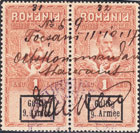
Photo 29
|
As a cancel, a cancel was used mainly double circle of diameter 34 and 25 mm, between which are printed in capital letters, ORTSKOMMANDATUR, and at the bottom Focsani. Within the small circle on the circle at the bottom, all in capitals STEUER - AMT and inside an eagle crowned.
The colors used were purple and lilac stamp.
Incidentally, on the revenues appears' stamp entry into the Hall Focsani. This stamp has the the outline of a rectangle double size 71/25 respectively 67.5 / 22 mm. Inside is engraved on two rows Focsani City Hall / entry Data N° Number. Stamping color was blue green.
Circulation and consumption of stamps
Taking into account the ranges with the largest numbers found, as well as a statistical calculation, results in a consumption:
. about 1082 pcs. at the 10 B;
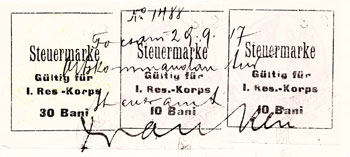
Photo 30
|
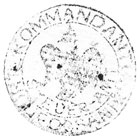
Photo 31
|
. about 978 pieces of 30 B value, as seen on the document presented series of 10 B is substantially equal to that of at 30 B, which leads to the conclusion that were issued were still so many documents charged by law with 30 B;
. the stamp of 1 L around 528, with most series that I saw is 368;
. stamp 5 L, with the highest series 126, with handwritten date 10/10/1917 and hence a consumption of about 130 pcs.
Stamps known so far
Tax stamps with overprint "Steuermarke Gültig für 1 Res-Korp" are some of the most rare Romanian revenue stamps, rarity explained by the fact that they have been used for a short time, only 33 days, was used a relatively small number of stamps and not the least, the destruction of documents produced by the precipitated withdrawal German army in their desire to remove any traces of the abuses that took place, knowing now about 1% of the stamps used.
The following is all the stamps I encountered so far, most part of personal collection.
 |
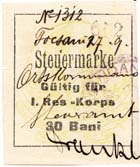 |
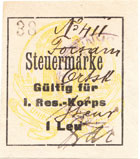 |
|
Photo 32
|
Photo 33
|
Photo 34
|
|
Conclusions
It was the first issue of local tax stamps were used by replacing General fiscal stamps. A second similar case is the latest Nasaud Revenues in 1945.
I tried drawing upon information available at this time, try some explanations about this issue, being aware of the remaining the enigmas such as:
1. Were printed in sheets? If so, how many were on the sheet? (I have not seen any pair);
2. Decisions of implementation and out of use. At the whose authority?
3. There have been no overprint? Whether have been ordered by the occupation authorities have been not marked on the drawing, together with the values and the rest of the overprint information?
4. Who was the designer?
Remains for the future, let's elucidate one.
Due to the small number of stamps used and reduced the period of use, this issue remains one of the Romanian Revenue rarities.
Their presence on the philatelic market is extremely rare and on the documents, a true "rare avis."
Bibliography:
Mihai Cojocar, "Catalogul timbrelor fiscale româneşti-2006";
Mihai Cojocar, "Catalogul timbrelor fiscale româneşti-2011";
John Brefoot & Valentin Robu "Bulgaria & Romania revenues" 2003;
Francisc Ambruş, "Catalog specializat al timbrelor fiscale, 1872-1919" 2010;
Col.P.V.Năsturel, "The flag, Romanian coat of arms, the princely marks, trophies" 1903
Adrian Apostu, 19/10/2011
|
 |
|
|

